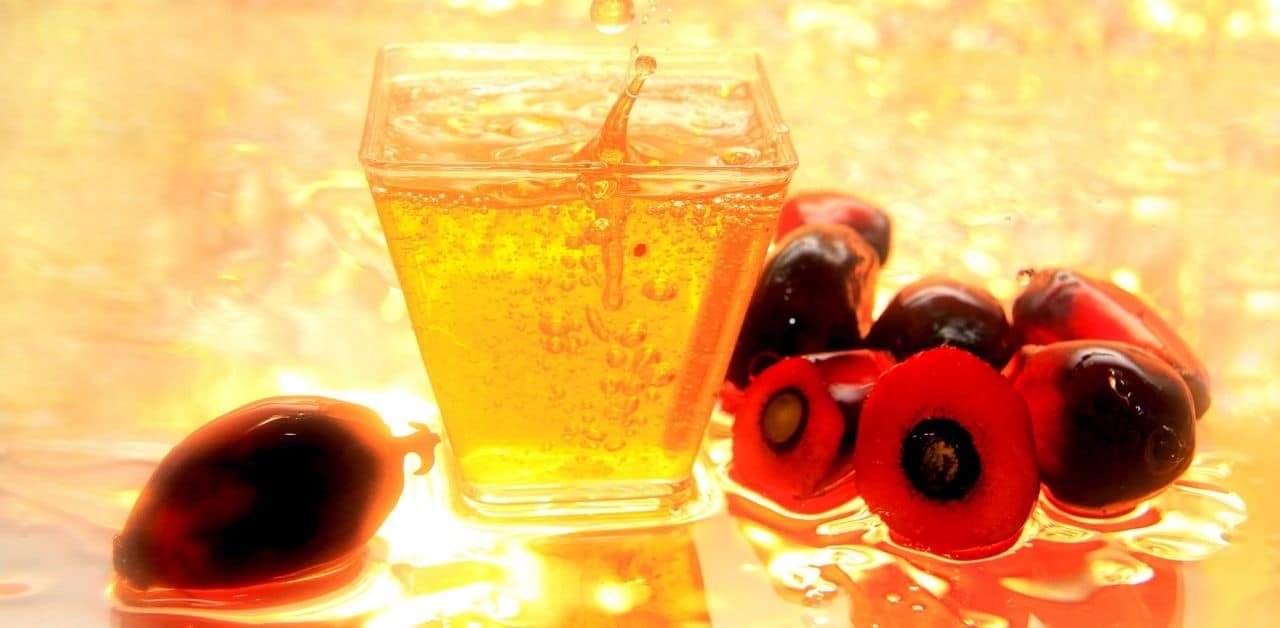Whether you view Palm Oil positively or negatively, it is inarguably one of the most intriguing products in today’s food manufacturing industry.
Palm Oil is used in so many everyday products (including many of the world’s most beloved snacks and other foods) that it is nearly impossible to avoid.
And unfortunately, this ubiquitous product is produced in a way that is unsustainable for the environment, indigenous communities, and the world’s ecosystems.
Over the last decade there has been a sharp rise in Sustainable Palm Oil production, but it is still not widely used in the production of most common goods.
In this list of 40 Fascinating Facts About Palm Oil, we’ll explore Palm Oil’s many uses, the reasons why it is unsustainable, the production of sustainable Palm Oil, and more…
READ MORE: How to Avoid Products With Palm Oil
Facts about Palm Oil Guide
- General Palm Oil Facts
- Deforestation for Palm Oil
- Palm Oil & Orangutans
- Facts About Sustainable Palm Oil
- Palm Oil Products List
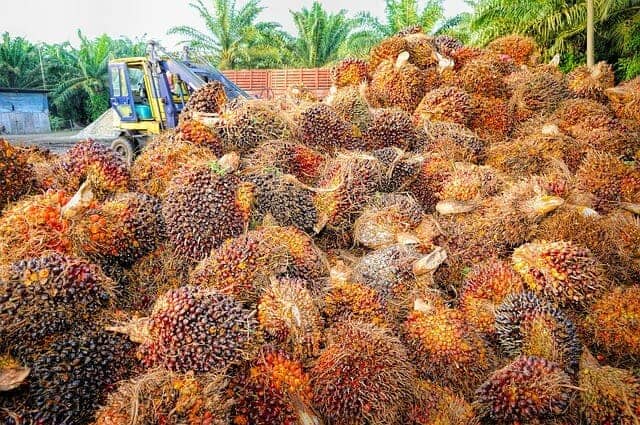
General Palm Oil Facts
1. Palm oil is the single most consumed vegetable oil in the world, with annual production of around 81.6 million tons (71 million metric tons), according to the United States Department of Agriculture.
2. China, India, Indonesia, and the European Union are the main consumers of palm oil, with US consumption currently at around 1,470 metric tons each year.
3. The Palm Oil plant is native to West Africa, and it thrives in any hot, wet tropical climate.
4. Over three-quarters of the planet’s Palm Oil comes from Indonesia and Malaysia.
5. It is extremely difficult to find Palm Oil-free products because there are over 25 different names for it! Here’s a list of the most common alternative names for Palm Oil, to help you avoid it when you shop:
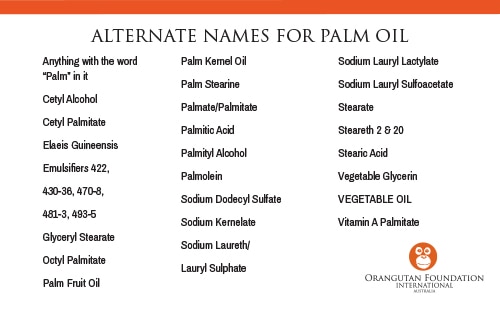
6. There are some noteworthy benefits of Palm Oil. For example, Palm Oil alternatives like sunflower, soybean, and rapeseed oil require a lot more land to produce the same amount of oil. So it is a very efficient crop for farmers.
7. Another benefit of Palm Oil is that palm trees produce 5-10 times as much oil as other crops.
8. A third benefit of palm oil is that it has certain unique properties, including its taste and high heat tolerance.
9. There are approximately 5 million farming families in Indonesia and Malaysia alone that rely on Palm Oil production for their income.
10. Of course, there are also myriad problems with Palm Oil that we will discuss later in this article, including deforestation and biodiversity loss…
11. One downside of palm oil is that foods with Palm Oil are often produced at the expense of local communities. Their land is often used without permission, and workers are exploited without fair wages or safe working conditions.
12. Another issue with Palm Oil is that it is not very healthy. Just one tablespoon of it contains about 55% of the daily recommendation for saturated fat consumption!
13. One thing that makes Palm Oil so devastating is the fact that, like GMO crops such as corn and soy, Palm Oil is produced on a massive scale. It now accounts for about 30% of the world’s vegetable oil production.
READ MORE: How to Design & Plant a Permaculture Food Forest Garden (DIY Guide)

Deforestation for Palm Oil
14. Palm Oil suppliers often target unprotected tropical rainforests, which are home to biodiverse ecosystems, to use for their plantations.
15. Palm Oil producers typically use a cost-effective “slash and burn agriculture” technique. This releases even more greenhouse gases, on top of removing the trees that absorb carbon from the atmosphere.
16. Clearing the area in this way makes Palm Oil Deforestation one of the biggest threats to wildlife diversity.
17. Deforestation for Palm Oil has caused the loss of over 8 million acres of vital forests in the South Pacific in just the last 20 years.
18. Palm Oil deforestation is not only destroying the habitat of many Asian animals, but also the indigenous peoples who live in the forest and depend on it for their survival.
19. Some locals are forcibly removed from their homes in order to make way for Palm Oil production.
20. If the indigenous peoples do not leave, they are often met with rising levels of soil and water pollution, and increased vulnerability to natural disasters like flooding and mudslides.
21. Looking for ways you can help stop the deforestation caused by Palm Oil? Sign petitions, only buy products with sustainable Palm Oil (or no Palm Oil), and share this story with others!
READ MORE: How Palm Oil Deforestation Contributes to Climate Change

Palm Oil & Orangutans
22. Recently, Palm Oil production has become the largest threat to Orangutans, which once ranged throughout Southeast Asia and South China.
23. According to the Orangutan Foundation International, between 1,000 and 5,000 Orangutans are killed because of Palm Oil every year.
24. The Bornean Orangutan is critically endangered largely because of the increasing popularity of Palm Oil production in Borneo.
25.Due to the slash and burn agriculture technique commonly used by Palm Oil producers, many Orangutans die from smoke inhalation.
26. Poaching and unlawful abduction also occurs when areas are being cleared for Palm Oil plantations, and Orangutans are sold into the illegal wildlife trade.
27. Fortunately, there are numerous conservation organizations working to rescue the Orangutans, including Yayasan International Animal Rescue Indonesia (YIARI).
28. YIARI has rescued 250+ Orangutans displaced by habitat loss, human-Orangutan conflict, or the illegal pet trade. Some Orangutans were translocated to safer forests, and approximately 100 are currently undergoing rehabilitation at the IAR Orangutan Rescue Centre.
29. Of course, supporting sustainable Palm Oil and avoiding Palm Oil entirely can help decrease the harm Palm Oil production causes to the wildlife of Southeast Asia.
30. Go to https://www.internationalanimalrescue.org/donate to donate!
READ MORE: How Fires in Indonesia & Palm Oil Kill Orangutans
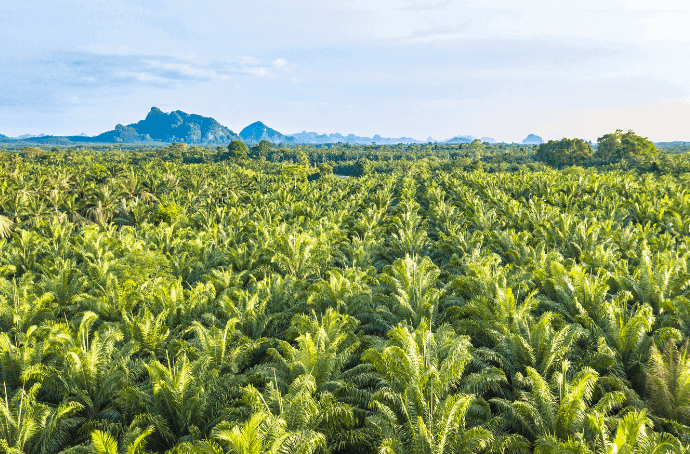
Facts About Sustainable Palm Oil
31. One important thing to remember is that the demand for Palm Oil will only increase in the future as global populations rise.
32. Because of the threat Palm Oil currently poses to climate change, indigenous peoples, and biodiversity, this inevitable increase in demand will require more devotion to sustainable Palm Oil production.
33. The Roundtable on Sustainable Palm Oil (RSPO) was established in 2004 with the objective of “promoting the growth and use of sustainable palm oil products through global standards and multi-stakeholder governance.”
34. The RSPO has 5,000 members from over 94 countries, and the organization annually verifies over 50 million tons of certified sustainable Palm Oil.
35. There are 8 criteria that palm oil suppliers must meet to be considered sustainable palm oil companies:
- Transparency with the RSPO
- Comply with laws and regulations
- Commitment to long-term economic viability
- Use of best practices
- Environmental responsibility and conservation
- Responsible consideration of employees, individuals, and communities
- Responsible development of new plantations
- Commitment to continuous improvement
36. The first detailed Life Cycle Assessment (LCA) study showed that RSPO-certified sustainable Palm Oil has 35% lower global warming impact and 20% lower biodiversity impact from land-use changes than non-certified Palm Oil produced in Indonesia and Malaysia.
37. Some experts claim that sustainable Palm Oil is a myth. But we here at GGT believe that it’s important to support the RSPO initiative, urging producers to adopt stricter regulations and more sustainable methods of production.
38. Increasing awareness of Palm Oil’s negative effects on the world’s climate, ecosystems, and people has made unsustainable palm oil bad for business. Consumers are gradually becoming more informed and cautious when shopping, and many actively search for sustainable Palm Oil products.
READ MORE: Sustainable Palm Oil: Fact or Fiction? A Look at RSPO Certification
Palm Oil Products List
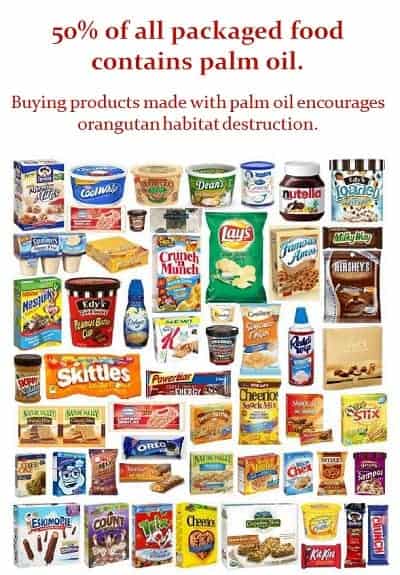
39. Most processed junk foods are foods that contain palm oil. So here’s a brief list of some of the many popular foods with Palm Oil:
- Bagel Bites
- Balance Bar
- Banquet
- Bertolli
- Bird’s Eye
- Blue Bonnet Table Spreads
- Boston Market
- Butterball Turkey
- Cadbury
- Canada Dry
- Cheez-Its
- Chef Boyardee
- Classico
- Clif Bar
- Country Crock
- Crunch N‘ Munch
- Pepper
- Earth Balance
- Egg Beaters
- Fleischmann‘s
- French’s Mustard
- Girl Scout Cookies
- Gulden’s Mustard
- Harmony Premium Trail Mix
- Hawaiian Punch
- Hebrew National
- Heinz Baby Food
- Heinz Ketchup
- Hellmanns
- Hunts
- Jack Daniels
- Jell-O No Bake Homestyle Cheese Cake Desert
- Jiffy Pop
- Keebler
- Kelloggs
- Knorr
- Knott‘s Berry Farm
- Kraft
- La Choy
- Lea & Perrins
- Libby‘s
- Lipton
- Little Debbie Snacks
- Luna Bar
- Manwich
- Marie Callender‘s Frozen Meals
- McDonalds
- Mott’s
- Fields Cookies
- Nabisco
- Newmans Own Organics
- Nissin Noodles / Ramen
- Nutella
- Ore Ida
- Oreo
- Orville Redenbachers
- PAM
- Parkay
- Pepperidge Farm Cookies
- Peter Pan
- Post Cereals
- Power Bar
- Quaker Oats
- Russell Stover Chocolates
- Schweppes
- South Beach Diet foods
- Soy Milk (various)
- Sun Ridge Farms
- Sweet’N Low
- Zone Perfect
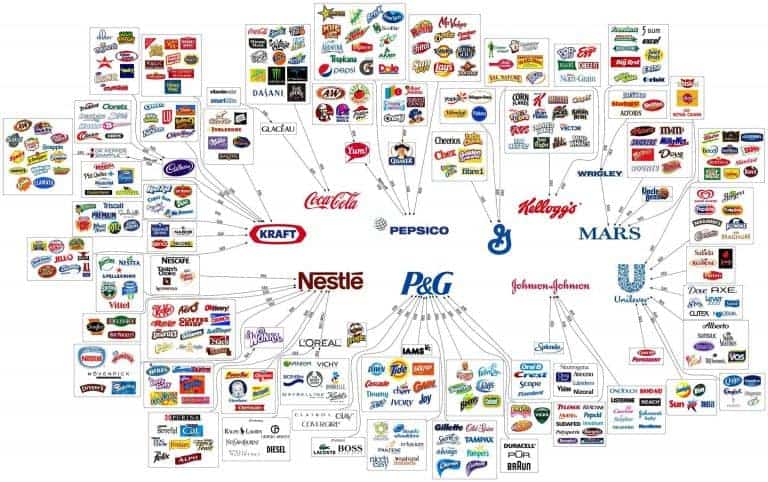
40. Palm Oil is also found in many other non-food items, like cleaning supplies, soaps and shampoos, makeup, and biofuel. Here’s a list of some big brands that still use Palm Oil in their products:
- Colgate-Palmolive
- Biofuel
- P&G
- Cover Girl
- Dial
- Herbal Essences
- Lancome
- Mary Kay
- Neutrogena
- Sephora
- Clinique
- L’Oreal
- L’Occitane
- Bliss
- Pacifica
- Tom’s of Maine
- Clarins
- Revlon
- Banana Boat
- Simply Cleaning Products
Hopefully these lists will lead you to do your own research, and help become a more environmentally-conscious consumer. Just say no to unsustainable Palm Oil products! –by Grace Bray; lead image via Canva
